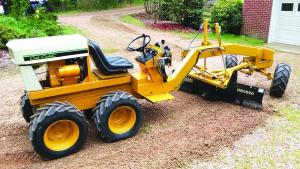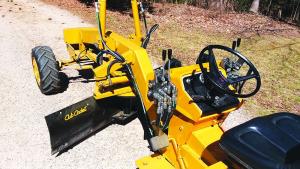Custom-Built Cub Cadet Motor Grader
Hartley “Frank” Smith’s Cub Cadet motor grader looks like it came from a factory. A 12 hp., Kohler K301 air-cooled engine powers the 2,000-lb, 13-ft. long motor grader. The all hydraulic, 5-ft. blade does everything a full-size grader can do and just as smoothly.
“I used a pair of 1970’s vintage, IH Cub Cadet garden tractors to build it,” says Smith.
He used hydrostatic rear ends from the 109 and 149 Cub Cadets, extending the one Cub frame by 3 ft. to allow for the second axle. He mounted the seat over the front drive axle with a Cub Cadet dash and dash tower ahead of it. A custom wheel well with a removable cover to access the hydraulics sits between the footrests.
The engine was mounted between the 2 rear axles after modifying the frame. Smith used 2 by 4-in. steel tubing to raise the engine above the axles. He ran a double belt pulley with toothed belts from the Kohler’s shaft to a driveshaft that runs between the hydrostats on the axles.
A trunnion activates forward and reverse action, activating the swash plates inside the 2 hydrostats. To synchronize the 2 axles, an adjustable length rod runs from the front hydrostat’s swash plate to the one on the rear hydrostat.
“I can jack the 2 axles off the ground and adjust the length of the rod until the 2 axles are in sync,” says Smith. “I found in a previous project that they don’t have to be in perfect sync, just close. If one slips, the other picks up the load.”
The only change made to the dash assembly was to add power steering from a later model Cub Cadet. He also mounted 5 spool valves on the dash. A pair on the right side control the blade’s vertical movement and left/right movement. A pair of spool valves on the left control the blade’s skew or pitch and its rotation. A fifth spool under the dash has a lever on the right side to insert and retract a locking pin on the blade’s turntable.
“All 5 spools are plumbed in series from the charge pump through the spools and back to the pump,” says Smith.
The dash is also home to throttle, choke, charging meter, speed control (forward/reverse), ignition switch and light switch, as well as a switch for a cooling fan for the transmission.
A 1/4-in. steel plate is the connection point between the lengthened tractor frame and the grader’s main frame. It is welded to both sides of the tractor frame. It is also welded to the rear end of the main frame’s 4 by 6-in., 1/4-in. thick, structural steel tubing that projects about 18 in. into and between the tractor frame.
“All the joints of the main frame were miter-cut and beveled to achieve full welding penetration,” says Smith. “I welded patch plates to the frame for extra strength where the highest load would take place.”
The triangular traction frame with the blade, turntable and hydraulic motor for adjusting the blade angle is suspended from the main frame by the vertical movement cylinders. At the front end of the grader, the traction frame attaches to the main frame with a ball hitch. The 1 7/8-in. ball hitch provides full freedom of movement as the various hydraulic cylinders adjust blade position.
A 3-in. dia. post is welded to a bracket on the blade. It comes up through the large, round, gear drive plate that adjusts the blade direction left or right. It also passes through an upper plate that is fastened to the traction frame. The post is held in place by a castle nut. Undo the castle nut, lift the frame up and the post and blade drop out.
Smith has decked the Cub Cadet motor grader out with a full set of lights for visibility and safety. “The lighting switch turns on headlights ahead of and behind the blades and lights to the rear,” he says. “If the motor grader is going forward, the rear lights are in red. If the grader is put in reverse, the rear lights turn white for greater visibility.”
Contact: FARM SHOW Followup, Hartley “Frank” Smith (woodandmetalshoptime@gmail.com).

Click here to download page story appeared in.
Click here to read entire issue
Custom-Built Cub Cadet Motor Grader TRACTORS Made-It-Myself Hartley “Frank” Smith’s Cub Cadet motor grader looks like it came from a factory A 12 hp Kohler K301 air-cooled engine powers the 2 000-lb 13-ft long motor grader The all hydraulic 5-ft blade does everything a full-size grader can do and just as smoothly “I used a pair of 1970’s vintage IH Cub Cadet garden tractors to build it ” says Smith He used hydrostatic rear ends from the 109 and 149 Cub Cadets extending the one Cub frame by 3 ft to allow for the second axle He mounted the seat over the front drive axle with a Cub Cadet dash and dash tower ahead of it A custom wheel well with a removable cover to access the hydraulics sits between the footrests The engine was mounted between the 2 rear axles after modifying the frame Smith used 2 by 4-in steel tubing to raise the engine above the axles He ran a double belt pulley with toothed belts from the Kohler’s shaft to a driveshaft that runs between the hydrostats on the axles A trunnion activates forward and reverse action activating the swash plates inside the 2 hydrostats To synchronize the 2 axles an adjustable length rod runs from the front hydrostat’s swash plate to the one on the rear hydrostat “I can jack the 2 axles off the ground and adjust the length of the rod until the 2 axles are in sync ” says Smith “I found in a previous project that they don’t have to be in perfect sync just close If one slips the other picks up the load ” The only change made to the dash assembly was to add power steering from a later model Cub Cadet He also mounted 5 spool valves on the dash A pair on the right side control the blade’s vertical movement and left/right movement A pair of spool valves on the left control the blade’s skew or pitch and its rotation A fifth spool under the dash has a lever on the right side to insert and retract a locking pin on the blade’s turntable “All 5 spools are plumbed in series from the charge pump through the spools and back to the pump ” says Smith The dash is also home to throttle choke charging meter speed control forward/reverse ignition switch and light switch as well as a switch for a cooling fan for the transmission A 1/4-in steel plate is the connection point between the lengthened tractor frame and the grader’s main frame It is welded to both sides of the tractor frame It is also welded to the rear end of the main frame’s 4 by 6-in 1/4-in thick structural steel tubing that projects about 18 in into and between the tractor frame “All the joints of the main frame were miter-cut and beveled to achieve full welding penetration ” says Smith “I welded patch plates to the frame for extra strength where the highest load would take place ” The triangular traction frame with the blade turntable and hydraulic motor for adjusting the blade angle is suspended from the main frame by the vertical movement cylinders At the front end of the grader the traction frame attaches to the main frame with a ball hitch The 1 7/8-in ball hitch provides full freedom of movement as the various hydraulic cylinders adjust blade position A 3-in dia post is welded to a bracket on the blade It comes up through the large round gear drive plate that adjusts the blade direction left or right It also passes through an upper plate that is fastened to the traction frame The post is held in place by a castle nut Undo the castle nut lift the frame up and the post and blade drop out Smith has decked the Cub Cadet motor grader out with a full set of lights for visibility and safety “The lighting switch turns on headlights ahead of and behind the blades and lights to the rear ” he says “If the motor grader is going forward the rear lights are in red If the grader is put in reverse the rear lights turn white for greater visibility ” Contact: FARM SHOW Followup Hartley “Frank” Smith woodandmetalshoptime@gmail com








